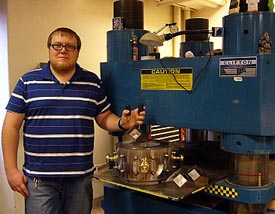
They are the building blocks of all life on Earth – molecules with large chains of carbon and hydrogen. Yet, on Mars, there relation to life has been somewhat of a mystery scientists have disagreed on for decades. These molecules, which have been the targets of missions to Mars from Viking to the present day, have been found in meteorites from Mars. The disagreement in the scientific world has been a question of origin regarding the organic compounds.
Theories as to their origin such as where did they come from, were they contaminated from Earth or other meteorites, are they remnants of ancient biological life or the result of chemical reactions such as volcanism on Mars.
The disagreement may be no more as researchers, led by Andrew Steele at the Carnegie Institution for Science and Francis McCubbin, a senior research scientist at the University of New Mexico's Institute of Meteoritics, have discovered, through a varied array of sophisticated research techniques, solid evidence this carbon did originate on Mars, but is not biological in origin.
Their work, published recently in Science/Science Express, provides insights into the chemical processes taking place on Mars and will be beneficial in future missions to Mars in the quest for evidence of life.
"I am not surprised that this organic carbon is unrelated to life because organic chemistry is a pre-requisite for biochemistry, however I was very surprised to learn the diversity of organic compounds that could be produced through common geological processes in the Martian mantle," said McCubbin, whose expertise involves understanding the magmatic history of planets based on meteorite studies.
The research team examined 11 Martian meteorites from a period spanning approximately 4.2 billion years. They detected large carbon molecules in 10 of them. The molecules were found inside of grains of crystallized minerals, which illustrated that at least some of the macromolecules of carbon were indigenous to the meteorites themselves and not contamination from earth.
Next, Steele and McCubbin looked at the carbon molecules in relation to other minerals on the meteorites, to see what kinds of chemical processing these samples encountered before arriving on Earth. The crystalline grains encasing the carbon molecules helped to provide a window into the creation of the carbon molecules. Their findings indicate that the carbon molecules were created during Volcanism on Mars and show that Mars has been undertaking organic chemistry for most of its history.
"These findings show that the storage of reduced carbon molecules on Mars occurred throughout the planet's history and might have been similar to processes that occurred on the ancient Earth," Steele said. "Understanding the genesis of these non-biological, carbon-containing macromolecules on Mars is crucial for developing future missions to detect evidence of life on our neighboring planet."
McCubbin developed the context of the research from the high temperature perspective and helped integrate it with the organic chemistry aspect of the research. He used Raman spectroscopy, electron probe microanalysis, scanning electron microscope and time-of-flight secondary ion mass spectrometry as primary techniques and other isotopic analyses.
"Specifically, I helped define the mechanism of formation of the organic carbon within the melt inclusions and helped interpret the textural context of that organic carbon," said McCubbin. "The most surprising part of this research was the massive effort required to make this work happen.
"This work lies at the interface of geology, planetary science, organic chemistry, analytical chemistry, and material science. Without having experts in all of these fields, this work would not have been possible."
The study, which has been ongoing for nearly five years, obtained the final piece of research, a generous allocation of a Martian meteorite, which fell in Morocco last year. Obtained from Curator and Director Carl Agee from the UNM Institute of Meteoritics, it was the most important piece of data that convinced the researchers of their previous five years of data and observations.
In a separate paper published recently by American Mineralogist, Steele and McCubbin studied a meteorite called Allan Hills 84001 that was reported to contain relicts of ancient biological life on Mars. The paper demonstrated that the supposed remnants could have been created by chemical reactions involving a form of carbon called graphite, which is used to make pencil lead, rather than biological remnants.
Both of these papers illustrate a pool of reduced carbon on Mars and will help scientists involved in future Mars missions to distinguish these non-biologically formed molecules from potential life.